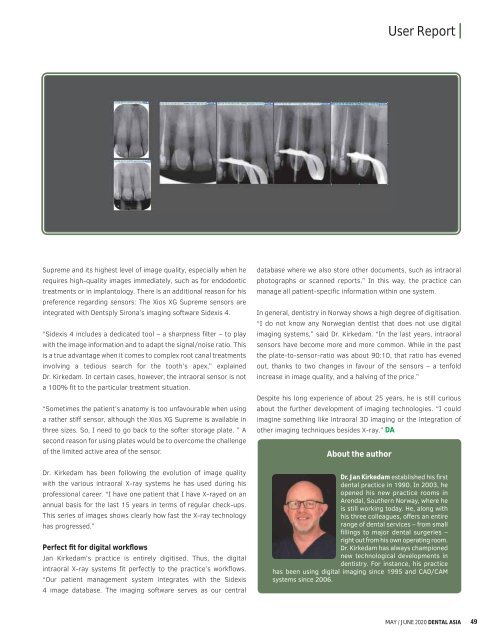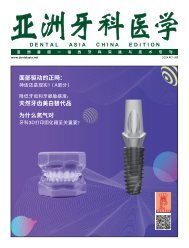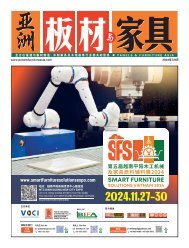Dental Asia May/June 2020
For more than two decades, Dental Asia is the premium journal in linking dental innovators and manufacturers to its rightful audience. We devote ourselves in showcasing the latest dental technology and share evidence-based clinical philosophies to serve as an educational platform to dental professionals. Our combined portfolio of print and digital media also allows us to reach a wider market and secure our position as the leading dental media in the Asia Pacific region while facilitating global interactions among our readers.
For more than two decades, Dental Asia is the premium journal in linking dental innovators
and manufacturers to its rightful audience. We devote ourselves in showcasing the latest dental technology and share evidence-based clinical philosophies to serve as an educational platform to dental professionals. Our combined portfolio of print and digital media also allows us to reach a wider market and secure our position as the leading dental media in the Asia Pacific region while facilitating global interactions among our readers.
Create successful ePaper yourself
Turn your PDF publications into a flip-book with our unique Google optimized e-Paper software.
User Report<br />
Supreme and its highest level of image quality, especially when he<br />
requires high-quality images immediately, such as for endodontic<br />
treatments or in implantology. There is an additional reason for his<br />
preference regarding sensors: The Xios XG Supreme sensors are<br />
integrated with Dentsply Sirona’s imaging software Sidexis 4.<br />
“Sidexis 4 includes a dedicated tool – a sharpness filter – to play<br />
with the image information and to adapt the signal/noise ratio. This<br />
is a true advantage when it comes to complex root canal treatments<br />
involving a tedious search for the tooth’s apex,” explained<br />
Dr. Kirkedam. In certain cases, however, the intraoral sensor is not<br />
a 100% fit to the particular treatment situation.<br />
“Sometimes the patient’s anatomy is too unfavourable when using<br />
a rather stiff sensor, although the Xios XG Supreme is available in<br />
three sizes. So, I need to go back to the softer storage plate. ” A<br />
second reason for using plates would be to overcome the challenge<br />
of the limited active area of the sensor.<br />
database where we also store other documents, such as intraoral<br />
photographs or scanned reports.” In this way, the practice can<br />
manage all patient-specific information within one system.<br />
In general, dentistry in Norway shows a high degree of digitisation.<br />
“I do not know any Norwegian dentist that does not use digital<br />
imaging systems,” said Dr. Kirkedam. “In the last years, intraoral<br />
sensors have become more and more common. While in the past<br />
the plate-to-sensor-ratio was about 90:10, that ratio has evened<br />
out, thanks to two changes in favour of the sensors – a tenfold<br />
increase in image quality, and a halving of the price.”<br />
Despite his long experience of about 25 years, he is still curious<br />
about the further development of imaging technologies. “I could<br />
imagine something like intraoral 3D imaging or the integration of<br />
other imaging techniques besides X-ray.” DA<br />
About the author<br />
Dr. Kirkedam has been following the evolution of image quality<br />
with the various intraoral X-ray systems he has used during his<br />
professional career. “I have one patient that I have X-rayed on an<br />
annual basis for the last 15 years in terms of regular check-ups.<br />
This series of images shows clearly how fast the X-ray technology<br />
has progressed.”<br />
Perfect fit for digital workflows<br />
Jan Kirkedam’s practice is entirely digitised. Thus, the digital<br />
intraoral X-ray systems fit perfectly to the practice’s workflows.<br />
“Our patient management system integrates with the Sidexis<br />
4 image database. The imaging software serves as our central<br />
Dr. Jan Kirkedam established his first<br />
dental practice in 1990. In 2003, he<br />
opened his new practice rooms in<br />
Arendal, Southern Norway, where he<br />
is still working today. He, along with<br />
his three colleagues, offers an entire<br />
range of dental services – from small<br />
fillings to major dental surgeries –<br />
right out from his own operating room.<br />
Dr. Kirkedam has always championed<br />
new technological developments in<br />
dentistry. For instance, his practice<br />
has been using digital imaging since 1995 and CAD/CAM<br />
systems since 2006.<br />
MAY / JUNE <strong>2020</strong> DENTAL ASIA 49


















